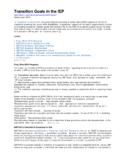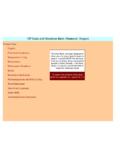Transcription of IEP Page 4 – Modified Subjects/Courses/Programs
1 Section 7 IEP Page 4 Developing Modified Program Page Page 1 of 10 Developing Modified Program Page 4 A " Modified Program page 4" will be developed for each subject/course selected as MOD on page 2 of the IEP. A Modified Program page 4 is created when a student requires changes to be made to the Ontario Curriculum expectations for a subject, in order to meet his/her learning needs. Modified refers to subjects/courses from the Ontario Curriculum in which the student requires curriculum expectations that vary from the regular grade expectations in one or more of the following ways: different grade level curriculum ( , a grade 6 student is working at grade 3 curriculum expectations for reading) a decrease in the number of curriculum expectations a change in the complexity of curriculum expectations The development of a Modified program page 4 is a collaborative process.
2 The subject teacher and other relevant members of the IEP development team should consult to consider the program goals and curriculum learning expectations that are appropriate for the student s instructional level. Principal's Signature By clicking the checkbox beside "Principal's Signature required", a signature line will appear on the top of the selected Page 4. The principal may enter signature: at the top of each program page 4 or once on the first of the program pages. Section 7 IEP Page 4 Developing Modified Program Page Page 2 of 10 Baseline Level of Achievement Baseline Level of Achievement : is the starting point for the development of the student's individual program provides benchmark data that allows for the measurement of student growth is taken from the most recent Provincial Report Card (typically from June of the previous year, unless the IEP is created mid year) remains unchanged for the duration of the school year since where the student started will never change There are 2 sections to the Baseline Level of Achievement for Modified subjects/courses: The left side.
3 Is used to enter the baseline data for content subjects such as Social Studies, History, Science and Technology, etc. The right side: Is used to enter the baseline data for English Language and Mathematics in order to accommodate the extra space required to enter the multiple strands of these subjects. Section 7 IEP Page 4 Developing Modified Program Page Page 3 of 10 Left Side: Entering Baseline for Content Subjects ( , as Social Studies, History, Science and Technology, etc.) For content subjects, using the left hand side of the Baseline Level of Achievement section, enter the following data: Letter grade/Mark: is taken from the most recent Provincial Report Card (typically from June of the previous school year, unless the IEP is created mid year) Letter Grade/Mark Based On refers to: the grade level of instruction for that subject ( , for content subjects, the grade in which the student was placed) Modified Curriculum check box: is checked if the expectations were Modified by decreasing the number and/or complexity of age-appropriate grade level curriculum.
4 Right Side: Entering Baseline for English Language and Mathematics If the student s program last year was Modified , include details regarding how each subject/strand was Modified Typically by grade level but different strands may have been based on different grade levels May have been Modified at grade level by reducing the number and/or complexity of the expectations Although it is not necessary to include a baseline for any strands that will not require modifications in the current year, they may be included here for clarification. For English Language and Mathematics, using the right hand side of the Baseline Level of Achievement section, enter the following data: The most current reporting date on which the subject grades or marks were based The grade/mark received in each strand The grade level on which the grades/marks for each strand were based Whenever possible, indicate if the student met end of year expectations in each strand or just beginning or mid-year by being specific (beginning, middle, end) Occasionally, even parts of a strand may have been based on different levels.
5 For example: Decoding /fluency may be at one level but reading comprehension may be at a different level. In that case, clarify by entering separate baseline levels for each. Section 7 IEP Page 4 Developing Modified Program Page Page 4 of 10 Annual Program Goal for a Modified Subject/Course The Annual Program Goal is based on everything you know about the student: Student s identification (if applicable) Results of professional and educational assessments Student s learning profile and learning preference Student s strengths and needs Student s pace of learning etc. The Annual Program Goal provides a clear statement indicating what student can reasonably be expected to achieve/accomplish by the end of the school year or semester.
6 It is an umbrella statement under which all the learning expectations will fall) Note: Annual Program Goals are written with the individual student in mind. Please do not copy any given samples verbatim. Annual Program Goal(s) for English Language and Mathematics Builds on the baseline level of achievement Is expressed as observable and measurable outcome (typically, the measure is the grade level) Includes essential learning for the student in that subject and/or strand in order to be successful at the next grade (for example: in order to be successful in reading at the grade 4 level, the student needs to decode/read with fluency and demonstrate understanding at a grade 3 level) Each strand must be addressed individually unless the student is functioning at the same grade level in all strands.
7 Provide an annual program goal only for those strands which are Modified , clearly stating whether or not the essential learning for a particular strand will be completed by the end of the year. When it is evident that the student will not meet the end of year expectations, smaller measures may be used, ( Beginning/ Middle/End of Grade 2). Stating percentage of curriculum to be completed ( "-will complete 50% of the grade 4 English curriculum"), is not an effective measure of progress and is not recommended in the Annual Program Goal. Typically, the annual program goal(s) remains unchanged for the entire school year but may be revised as the teacher develops a better understanding of the student's learning processes and/or as the student s rate of acquisition of knowledge and skills changes.
8 Section 7 IEP Page 4 Developing Modified Program Page Page 5 of 10 Annual Program Goal(s) for English Language and Mathematics, continued When all strands are at the same level, one goal statement may be used: When each strand is at a different level, address each strand separately: Do not include in the annual program goal, strands that do not require modifications. (In the examples above, Media Literacy was not included.) Annual Program Goals for other subject areas such as Social Studies, Science and Technology, History, etc. The Annual Program Goal: Is a reasonable, challenging, yet achievable target Is expressed in terms of observable achievement Includes essential learning or skill development for the student in that subject in order to be successful at the next grade May be expressed in terms of observable achievement in the development of thinking skills such as memory, inquiry/research, analysis, integration, application, etc.
9 May be developed from overall expectations Note: Annual Program Goals are written with the individual student in mind. Please do not copy any given samples verbatim. Section 7 IEP Page 4 Developing Modified Program Page Page 6 of 10 Learning Expectations / Teaching Strategies / Assessment Methods for Modified Subjects/Courses Learning expectations are the core of the IEP. They are based on everything the teacher knows about the student. The learning expectations selected should include what is critical and essential learning for that student. Learning Expectations: are written as performance tasks or learning outcomes, based on learning expectations of Ontario curriculum policy documents are expressed in clear, precise, user friendly language for educators, parents and students are developed at the beginning of each term/semester are reviewed and revised by term/semester or whenever assessment warrants revision include notation of curriculum grade level after each expectation (the grade level on which the expectation is based) Learning Expectations are performance tasks or learning outcomes that will be used to.
10 Indicate specific knowledge and/or skills the student is expected to demonstrate independently support the annual program goal evaluate the student determine letter grades/marks for the Report Card develop anecdotal comments for the Report Card Teaching Strategies: support the student in achieving the learning expectations correlate directly to the specific expectation differ from strategies used with other students are selected keeping in mind, the student s strengths, needs and learning style be sure to include any specific equipment/software the student is using to access curriculum learning expectations (for example, use of text-to speech software to assist with reading comprehension). It is possible that some learning expectations do not require different teaching strategies and therefore this box may be empty.







